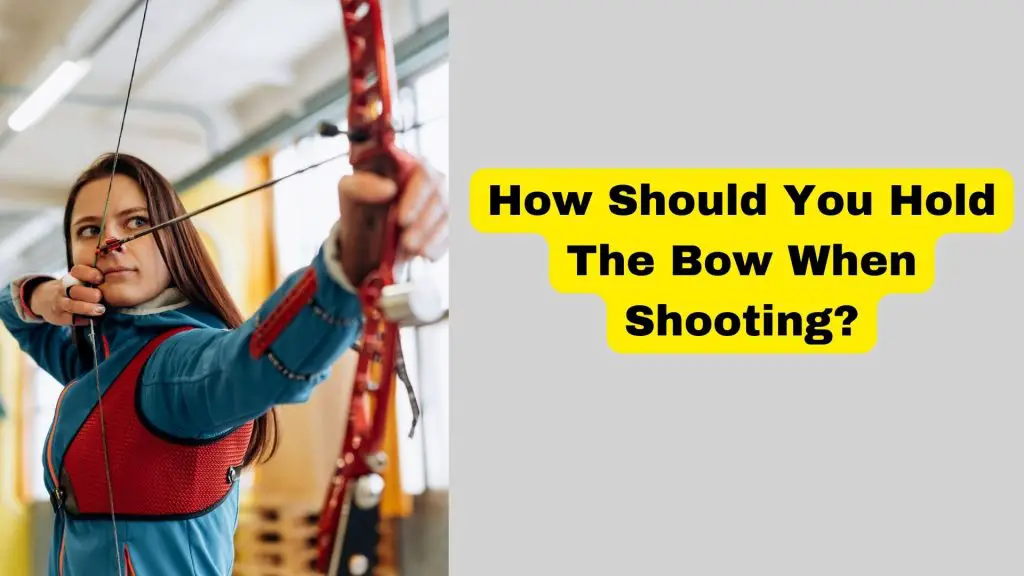How Should You Hold The Bow When Shooting?
Archery is a sport that requires precision and focus. The slightest mistake in form or technique can result in missed shots or even injury.
A successful archery shot relies on many different factors working together in harmony to produce consistent results. One such factor is the grip, which is among the easiest aspects of form to master. By improving your grip, you can quickly increase the accuracy of your shots.
Regardless of whether you shoot a longbow, Olympic recurve, or compound bow, the fundamentals of a good grip remain the same. A proper grip should not have much influence on the bow, while still providing it with strong support.

In this article, we will discuss the different ways to hold a bow when shooting. We will discuss the gripping techniques i.e the basic grip, the thumb grip, and the finger grip.
We will also explore the advantages of each grip and how to avoid common mistakes while using them.
Finally, we will provide recommendations on choosing the right grip based on factors such as archery style, bow type, hand size, and personal preference.
Whether you are a beginner or an experienced archer, understanding how to properly hold a bow is essential to improving your skills and achieving success on the range.
So, let’s dive into different bow grips and learn how to take your archery game to the next level.
Basic Bow Grip
The basic bow grip is the most common way to hold a bow when shooting.
It is a simple and straightforward technique that is suitable for most archers, especially beginners.
The basic grip involves placing your hand around the bow’s handle, with your fingers resting lightly on the bow’s grip.
Advantages of using the basic grip:
- It is easy to learn and can be used with most bow types.
- It provides a stable and secure grip on the bow.
- It allows for better control over the bowstring.
How to hold the bow using the basic grip:
- Stand in the correct shooting stance with your feet shoulder-width apart.
- Place the bow handle in the center of your palm.
- Wrap your fingers around the grip and rest your thumb on the opposite side of the bow.
- Keep your fingers relaxed and lightly touching the bow grip.
Common mistakes to avoid while using the basic grip:
- Gripping the bow too tightly, which can cause tension and affect accuracy.
- Placing your thumb over the top of the bow, which can interfere with the bowstring’s movement.
- Allowing your fingers to slide down the bow grip, which can affect your aim.
Overall, the basic grip is an excellent starting point for anyone learning how to shoot a bow. However, it may not be the best option for everyone, as different archers may have different preferences or needs. In the next section, we will explore two alternative bow grips: the thumb grip and the finger grip.
Alternatives to the Basic bow grip
While the basic bow grip is suitable for most archers, some may prefer an alternative grip that suits their individual needs or preferences.
Here are two common alternatives: the thumb grip and the finger grip.
Thumb Grip
The thumb grip, also known as the Mediterranean grip, involves placing the bow handle in the palm of your hand and wrapping your fingers around the grip.
Instead of resting your thumb on the opposite side of the bow, you place it along the side of the bow, pointing toward the target.
Advantages of using the thumb grip:
- It allows for a more relaxed grip on the bow.
- It can help with consistent hand placement and aim.
- It reduces the risk of the bowstring hitting your arm.
How to hold the bow using the thumb grip:
- Stand in the correct shooting stance with your feet shoulder-width apart.
- Place the bow handle in the center of your palm.
- Wrap your fingers around the grip.
- Rest your thumb along the side of the bow, pointing toward the target.
Common mistakes to avoid while using the thumb grip:
- Placing your thumb too high or too low on the bow, which can affect your aim.
- Gripping the bow too tightly, which can cause tension and affect accuracy.
- Allowing your fingers to slide down the bow grip, which can affect your aim.
Finger Grip
The finger grip, also known as the Eastern grip, involves holding the bow handle between your first and second fingers, with your thumb resting lightly on the opposite side of the grip.
Advantages of using the finger grip:
- It allows for a more relaxed grip on the bow.
- It can provide better control over the bowstring.
- It can help with consistent hand placement and aim.
How to hold the bow using the finger grip:
- Stand in the correct shooting stance with your feet shoulder-width apart.
- Hold the bow handle between your first and second fingers.
- Rest your thumb lightly on the opposite side of the grip.
Common mistakes to avoid while using the finger grip:
- Gripping the bow too tightly, which can cause tension and affect accuracy.
- Allowing your fingers to slide down the bow grip, which can affect your aim.
- Placing your fingers too close together or too far apart, which can affect your grip.
It is important to note that while these alternative grips may work well for some archers, they may not be suitable for everyone. It is essential to experiment with different grips and find the one that works best for you.
In the next section, we will discuss how to choose the right grip based on your individual needs and preferences. But, Before that let give you a useful video on how to grip a bow.
Choosing the Right grip
Choosing the right grip for your bow is essential to improve your performance and accuracy.
Here are some factors to consider when selecting a grip:
A. Archery style
Different archery styles may require different grips. For example, Olympic-style archers often use the finger grip, while traditional archers may prefer the thumb grip. It is important to consider your archery style when choosing a grip.
B. Bow type
The type of bow you use can also influence your grip choice. For example, recurve bows may work well with the basic grip or the thumb grip, while compound bows may be more suitable for the finger grip.
C. Hand size
Your hand size can also affect your grip choice. If you have larger hands, you may find it more comfortable to use the basic grip, while those with smaller hands may prefer the thumb grip.
D. Personal preference
Ultimately, your personal preference should also play a role in choosing a grip. Experiment with different grips and choose the one that feels most comfortable and natural to you.
It is important to note that regardless of the grip you choose, proper form and technique are crucial for success in archery. Be sure to practice consistently and work on your form to improve your skills.
What are The 7 steps In Archery?
The 7 steps of archery are a sequence of movements that an archer follows in order to make a successful shot.
These steps are:
- Stance: Begin by positioning your feet on the shooting line. Your right foot should be straddled directly above your left foot.
- Nocking: Hold the bow with your non-dominant hand extended toward the target. Nock an arrow onto the bowstring, ensuring that it is secure.
- Drawing: Draw the bowstring back to its full extent, using your dominant hand to grip the bowstring.
- Anchoring: Anchor the bowstring with your non-dominant hand against your face or chest. This will provide a consistent anchor point for each shot.
- Aiming: While keeping the bow steady, aim at the target using your dominant eye. Draw the bowstring back as far as comfortable without releasing it entirely.
- Holding: Hold the bow steady until you have a clear picture of where you want to aim and where that may be on your shot.
- Release: Release the bowstring entirely and follow through with pressure on either side of your release point (on each side). This will ensure that your arrow flies straight and true to the target.

Why Is It a Bad Thing to Tightly Grip the Bow?
Tightly gripping the bow is a common mistake many archers make, especially beginners.
It may seem intuitive to grip the bow tightly to maintain control and stability, but this actually has a negative impact on your shooting accuracy and can lead to injury.
- One of the main reasons why tightly gripping the bow is a bad thing is that it causes your muscles to tense up and shake. When your muscles are tense, they become less stable and more likely to vibrate, which can cause your bow to move and affect the path of the arrow. This can result in inaccurate shots and missed targets.
- Moreover, a tight grip can also cause the bow to wiggle back and forth after the arrow has been released. This movement can cause the bowstring to hit your inner elbow, causing pain and injury. This is commonly known as the “archer’s paradox,” and it occurs when the bowstring moves in a different direction than the bow after the arrow has been released.
To avoid these issues, it is important to maintain a relaxed grip on the bow. This allows your muscles to remain calm and stable, reducing the likelihood of vibrations and wobbling.
You should also focus on using your back muscles to hold the bow steady, rather than relying on your hands and arms to grip it tightly.
ChecK: Do Crossbows Have Recoil?
Conclusion
Holding the bow correctly is essential for success in archery. Whether you are a beginner or an experienced archer, understanding the different types of bow grips and choosing the right one for your needs is crucial.
Check: Should I Choose A RIGHT- OR LEFT-HANDED BOW?
The basic bow grip is a great starting point for most archers, providing a stable and secure grip on the bow. However, some archers may prefer an alternative grip, such as the thumb grip or the finger grip, to suit their individual needs and preferences.
When choosing a grip, consider factors such as your archery style, bow type, hand size, and personal preference. Experiment with different grips and choose the one that feels most comfortable and natural to you.
Remember, regardless of the grip you choose, proper form and technique are crucial for success in archery. Be sure to practice consistently and work on your form to improve your skills.
By mastering the art of holding the bow correctly, you can improve your accuracy, precision, and overall performance in archery. Happy shooting!
Resource: https://www.wikihow.com/Hold-an-Archery-Bow
